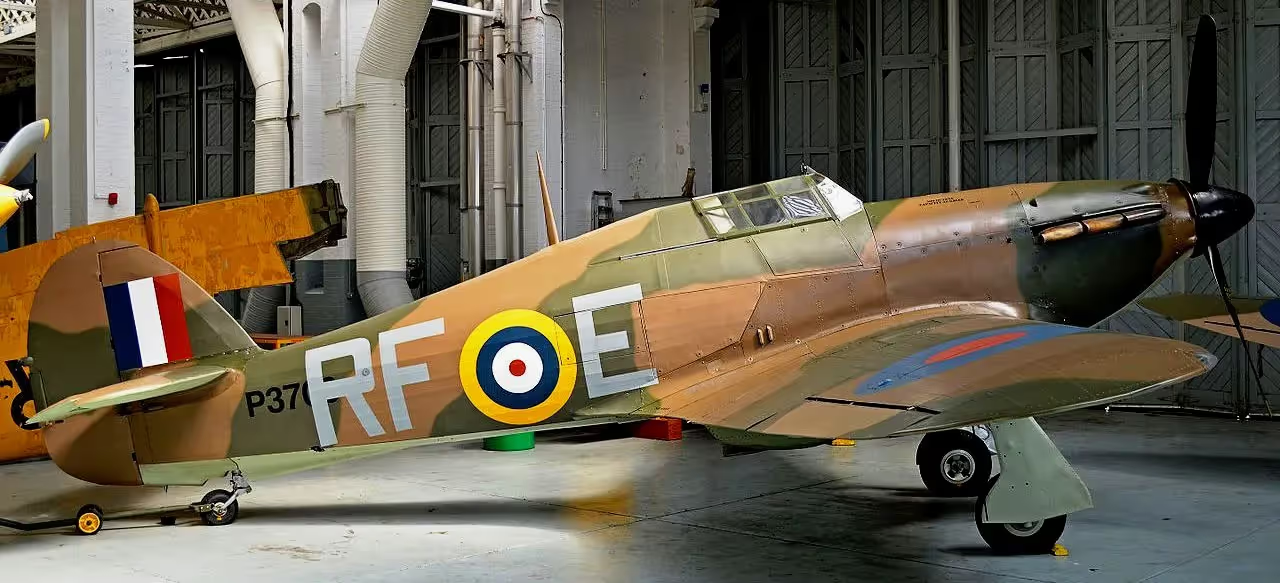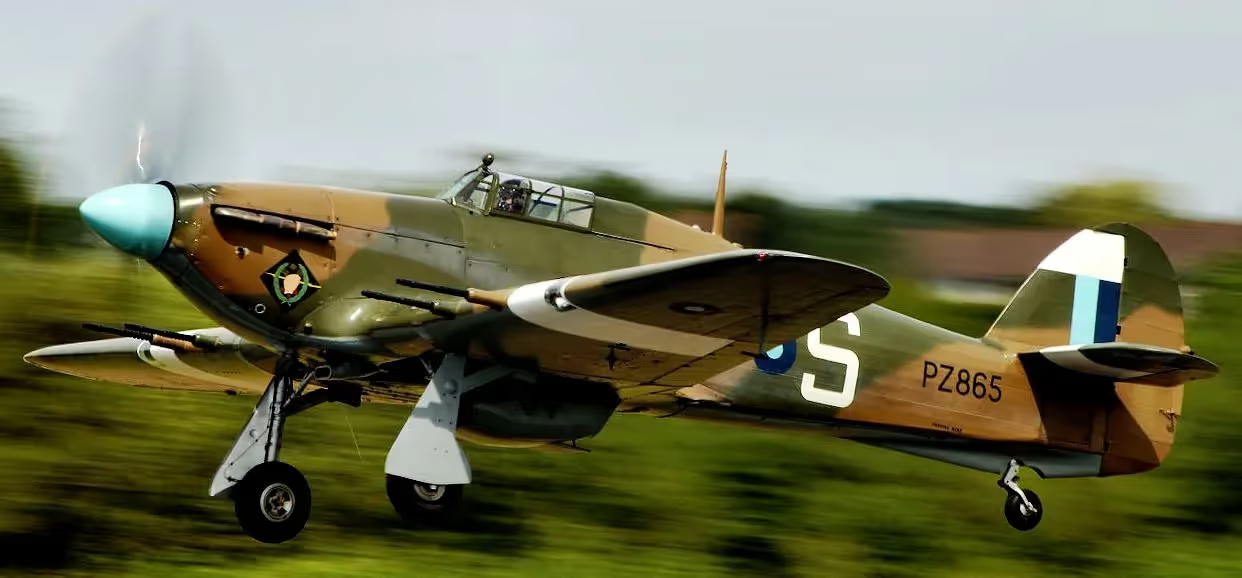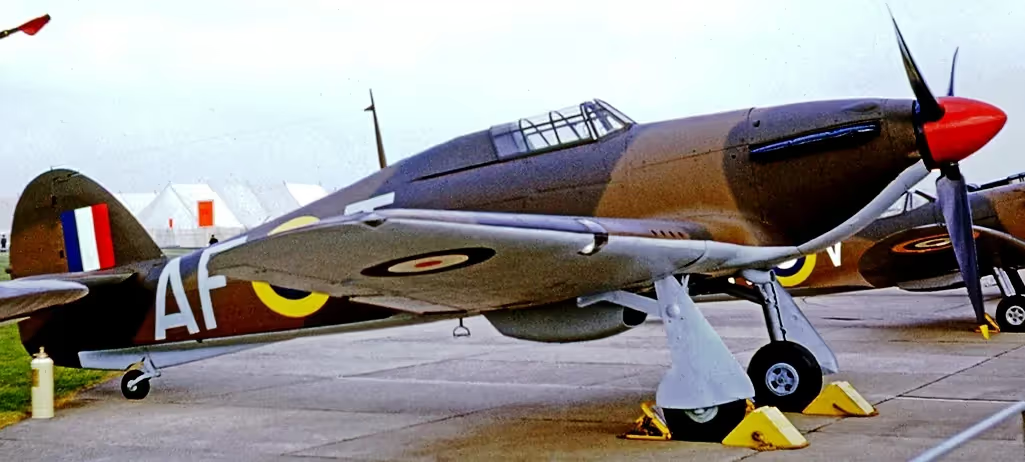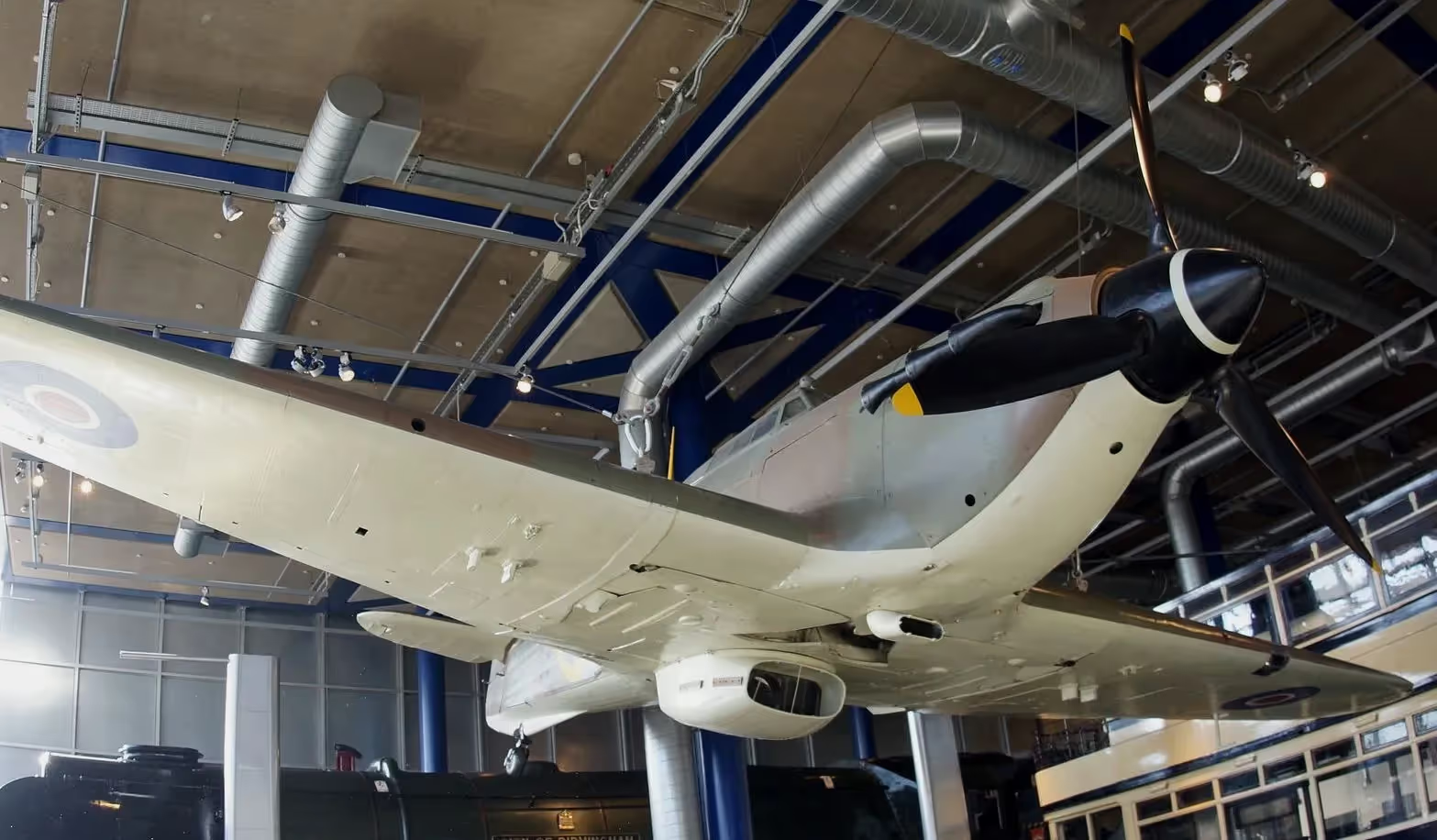Warplanes of the UK: Hawker Hurricane
Hawker Hurricane
The aim of this website is to locate, identify and document Hawker Hurricanes preserved in the United Kingdom. Many contributors have assisted in the hunt for these aircraft to provide and update the data on this website. Photos are by the author unless otherwise credited. Any errors found here are by the author, and any additions, corrections or amendments to this list of Warplane Survivors of the Second World War in the United Kingdom would be most welcome and may be e-mailed to the author at [email protected].

(RAF Photo)
Six Hurricane Mk IIBs of 'B' Flight, No. 601 Squadron RAF based at Duxford, Cambridgeshire, flying in starboard echelon formation near Thaxted, 21 August 1941.

(IWM Photo, C851)
Trainee airframe fitters are taught repair procedures on Hawker Hurricane instructional airframe, (Serial No. 1359M), in a hangar at No. 2 School of Technical Training, Cosford, Shropshire. The Hurricane formerly (Serial No. L1995) flew with No. 111 Squadron RAF before crashing during a forced landing in January 1939. More instructional airframes, including Bristol Blenheim Mark Is and a Fairey Battle, can be seen in the background.
Hawker Hurricanes preserved in the United Kingdom by aircraft type, serial number, registration number and location:




(Adrian Pingstone Photos)

(Mike Burdett Photo)
Hawker Hurricane Mk. I (Serial No. R4118), coded UP-W, No. 605 Squadron, Reg. No. G-HUPW), Peter and Polly Vacher, Oxfordshire, kept with the Shuttleworth Collection, Old Warden, Bedfordshire. Airworthy.
Hawker Hurricane Mk. I fuselage frame (Serial No. P3708), Norfolk and Suffolk Aviation Museum, Flixton, Bungay, Suffolk.

(IWM Photo, A9534)
Six Fleet Air Arm Hawker Sea Hurricane Mk. IBs operating from Yeovilton, flying in formation, Dec 1941.






(Alan Wilson Photos)

(Adrian Pingstone Photo)


(John5199 Photo)






(Tim Felce Photo)

(Paul Maritz Photo)

(Mike Freer - Touchstone-aviation Photo)
Hawker Sea Hurricane Mk. Ib (Serial No. Z7015), Reg. No. G-BKTH, No. 759 Squadron and No. 880 Squadron of the Fleet Air Arm, HMS Indomitable, The Shuttleworth Collection, Old Warden, Bedfordshire. Airworthy.

(Greg Goebel Photo)
Hawker Sea Hurricane Mk. X (Serial No. AE977), coded LE-O, No. 242 Squadron, painted as a Mk. I, G-ZL, Biggin Hill Heritage Hangar. This aircraft was built at Fort William, Ontario in Canada as a Mk. Ia, later designated Mk. X, and arrived in the UK on 21 April 1941. Reg. No. G-TWTD, and later G-CHTK, previously painted as (Serial No. P3886), currently wearing the markings of No. 32 Squadron.

(Alan Lebeda Photo)

(Andre Wadman Photo)




(Alan Wilson Photos)



(Aldo Bidini Photos)

(Laurent Bouvier Photo)


(Tim Felce Photos)
Hawker Hurricane Mk. XII, RCAF (Serial No. 5711), C/N 72036, built by Canadian Car and Foundry (CCF) at Fort William, Ontario, ex- RAF (Serial No. P3700), painted as RAF (Serial No. Z5140), Reg. No. G-HURI, This Canadian-built Hurricane is painted as a Mk. I, coded RF-E, No. 303 Polish Squadron, Historic Aircraft Collection (HAC), Duxford, Cambridgeshire.

(Allen Watkin Photo)

(Alan Wilson Photo)

(Clemens Vasters Photo)

(Roland Turner Photo)

(Mark Harkin Photo)
Hawker Hurricane Mk. IIb (Serial No. Z2315), coded JU-E, No. 111 Squadron. This is a former Russian operated aircraft on display at the Imperial War Museum, Duxford.


(Tony Hisgett Photos)

(Adrian Pingstone Photo)

(tataquax Photo)

(Kogo Photo)

(Mark Harkin Photo)


(Mike Freer - Touchdown-aviation Photos)

(James Photo)
Hawker Hurricane Mk. IIc (Serial No. LF363), coded JX-B, previously coded GN-F, YB-W and UF-C, Battle of Britain Memorial Flight, RAF Coningsby, Lincolnshire. Airworthy. GN-F honours Wing Commander Tom Neil, DFC*, AFC, AE, No. 249 Squadron, 1940.

(RAF Photo)
Hawker Hurricane Mk IVD (Serial No. KZ193) with a pair of Vickers “S” 40mm anti-tank guns. Superseded by 3 inch Rocket Projectiles. No. 6 Squadron proved the concept, Nos. 137 and 164 Squadrons used them in Europe briefly before receiving Typhoons, then Nos. 5 and 20 Squadrons used them in Burma. (Ian Hewins)

(Kogo Photo)


(Mike Freer - Touchdown-aviation Photos)

(Ronnie Macdonald Photo)

(Tim Felce Photo)

(Tony Hisgett Photo)

(Adrian Pingstone Photo)

(Alan Wilson Photo)


(Cpl Phil Major (RAF)/MOD Photos)


(Mark Harkin Photo)
Hawker Hurricane Mk. IIc (Serial No. PZ865), first flown in late July 1944, No. 34 Squadron colours, South East Asia Command, Reg No. G-AMAU, Battle of Britain Memorial Flight, RAF Coningsby, Lincolnshire. Airworthy.


(Paul Nelhams Photos)




(Stephan Krause Photos)


(Tim Felce Photos)

(Mike Freer - Touchstone-aviation Photo)



(Julian Herzog Photos)

(Tony Hisgett Photo)

(Adrian Pingstone Photo)
Hawker Hurricane Mk. IIb (Serial No. BE505), built by the Canadian Car Foundry (CCF), RCAF (Serial No. 1374), Reg. No. G-HHII, (Hurribomber), Peter Teichman, Hangar 11 Collection, North Weald. Airworthy. Built at Fort William, Ontario as a Mk. I (Serial No. AG287), for the RAF, transferred to the RCAF, No. 125 Squadron on 30 Apr 1942 at Sydney, Nova Scotia, and later No. 128 Squadron, also based at Sydney on 7 June 1942. Converted to Mk. XIIA at Fort William, fitted with 12-gun wings and flown by No. 1 Operational Training Unit at Bagotville, Quebec from 18 Nov 1943. Written off in a crash on 22 Apr 1944. Airworthy. This Hurricane is the world's only two-seater with a split canopy and dual controls.

(Alan Wilson Photo)
Hawker Hurricane Mk. I (Serial No. P2902), DX-R, "R for Robert", No. 245 Squadron B Flight, Reg. No. G-ROBT, recovered wreck that crashed 31 May 1940, Rick Roberts, Hawker Restorations Limited, Sudbury, Suffolk. Airworthy again, returned to flight on 19 June 2017.

(Alan Wilson Photo)
Hawker Hurricane Mk. I (Serial No. P3717), coded SW-P, Reg. No. G-HITT, ex-USSR,converted to Mk. IIA standard in 1941, composite aircraft painted in the markings of No. 253 Squadron. Hugh Taylor, Hawker Restorations Limited, Sudbury, Sufolk.
Hawker Hurricane Mk. I (Serial No. V7497), coded X-SD, Reg. No. G-HRLI. This aircraft flown by Pilot Officer Everett Rogers, No. 501 Squadron, was shot down on 28 Sep 1940 during the Battle of Britian, by a Messerschmitt Bf 109 flown by Gustav Sprick. Rogers baled out and survived. The wreck was recovered from its crash site and is jointly owned by Peter Kirkpatrick and Hawker Restorations. The aircraft will be based at Duxford. It is Airworthy, as of 30 Aug 2018.
Hawker Hurricane Mk. I (Serial No. L1639), 85 Squadron, being restored to airworthy, Cambridge Bomber and Fighter Society, Little Gransden Airfield, Cambridgeshire. L1639 is a Battle of France veteran, shot down over the north of France on 14 May 1940, while being flown by Squadron Leader James B. Parnall of No. 504 Squadron. Other airframes involved in the restoraton of this aircraft include (Serial Nos. Z4035, P3895, BD731 and BFD736). The restoration crew plans to have a running engine, and will have the fighter painted in the markings of No. 85 Squadron, coded VY-Q, during the Battle of France in 1940.
Hawker Hurricane Mk. IIb (Serial No. Z5207), ex-USSR, Reg. No. G-BYDL, Retro Track and Air, Gloucestershire.
Hawker Hurricane Mk. IIb (Serial No. BH238), ex-USSR, wreck, privately owned, Isle of Wight.
Hawker Hurricane Mk. XII, RCAF (Serial No. 5487), Canadian-built, crashed in 1942, being restored, Reg. No. G-CBOE, privately owned in Hampshire.


(Alan Wilson Photos)
Hawker Hurricane Mk. I (Serial No. L1592), No. 615 Squadron, Science Museum, Kensington, London.


(Alan Wilson Photos)

(RuthAS Photo)

(Alan Wilson Photo)


(Hugh Llewelyn Photos)

(Roland Turner Photo)

(Daniel Perez Photo)
Hawker Hurricane Mk. I (Serial No. P2617), No. 607 Squadron, Royal Air Force Museum Hendon, London.

(Hugh Llewelyn Photo)
Hawker Hurricane Mk. I (Serial No. P3175), No. 257 Squadron, crashed 31 August 1940, wreck is on display at the Royal Air Force Museum Hendon, London.

(ell Brown Photo)

(Birmingham Museums Trust Photos)

(Sasha Taylor Photo)
Hawker Hurricane Mk. IV (Serial No. KX829), painted as (Serial No. P3395), No. 1 Squadron, Thinktank, Birmingham Science Museum, West Midlands.


(Alan Wilson Photos)
Hawker Hurricane Mk. IIa (Serial No. Z2389), Brooklands Museum, Weybridge, Surrey. Built in Dec 1940 at Langley. After serving in the UK with No. 249 "Gold Coast" Squadron, and briefly with No. 71 "Eagle" Squadron, No. 247 Squadron and No. 136 Squadron, and No. 253 Squaron, this Hurricane went to Russia as part of the lend-lease program. It was shot down on 20 June 1942 after engaging two Messerschmitt Bf 109s and five Bf 110s. The pilot, FLt Ivan Kalashnikov, successfully force-landed in remote terrain. Its wreckage was recovered in 1996 and it has being restored, painted in Eagle Squadron colours. It is on display at Brooklands.

(Clemens Vasters Photo)

(Allen Watkin Photo)

(Alan Wilson Photo)
Hawker Hurricane Mk. IIb (Serial No. Z3215), ex-USSR, No. 111 Squadron, Reg. No. BE146, Imperial War Museum, Duxford, Cambridgeshire.

(Nilfanion Photo)
Hawker Hurricane Mk. II (Serial No. LF751), painted as (Serial No. BN230), A-FT, No. 43 Squadron, Hurricane and Spîtfire Memorial Museum, Manston, Kent.

(Nimbus227 Photo)
Hawker Hurricane Mk. II (Serial No. LF738), UH-A, Royal Air Force Museum Cosford, Shropshire.
Hawker Hurricane Mk. IV (Serial No. KZ191), ex-Israeli Defence Force, privately owned, Berkshire.
Hawker Hurricane Mk. XII (Serial No. BW881), Reg. No. G-KAMM, previously in the UK. This aircraft is now with the Flying Heritage Collection, Everett, Washington. Airworthy.

(Kogo Photo)
Hawker Hurricane Mk. XIIb, ex-RCAF (Serial No. 5589), LK-A, Canadian built, painted as (Serial No. BD707), Reg. No. G-HURR, destroyed in a crash on 15 Sep 2007.
Hawker Hurricane Mk. I (Serial No. L2005) is being restored as a two-seat version with the pilots controls in the front and a passenger seat behind under a slightly longer sliding hood. The two-seat modifications have been designed so the aircraft can be easily converted back to a single-seat model. Only one was actually built and sold to Persia. Suffolk-based Hawker Restorations will restore it in the markings of No. 151 Squadron from North Weald. This aircraft was shot down over Kent on 28 Aug 1940.
.avif)
(RAF Photo)
Hawker Hurricane Mark IIC (Serial No. BE500), coded LK-A, being flown by Squadron Leader Dennis Smallwood, the Commanding Officer of No. 87 Squadron RAF based at RAF Charmy Down, Somerset, UK. No. 87 Squadron was one of the first RAF night fighter squadrons. S/L Smallwood led the squadron in 1941-42, when most intercepts were made entirely without on-board radar. He later became an Air Chief Marshall. The aircraft is painted in an overall black scheme known in the RAF as "Special Night". BE500 subsequently served with No. 533 Squadron RAF and finally in the Far East, early in 1942.





